From Hatching to Day 12
ATTENTION: If you watch nestling growth and development and are concerned because one or more Tree Swallow nestlings is not growing well and is significantly smaller than its nestmates, or if there has been a prolonged period of bad weather, or if you have nestlings you believe may need human intervention in order to grow and survive, please read and consider the possible intervention options below:
- Fostering Tree Swallow Nestlings
- Hand-Feeding Tree Swallow Nestlings in the Field
- Temporary Care of Tree Swallow Nestlings
At Your Boxes:
There are small nestlings in almost every box now. When you check nests you may have to take them out to get an accurate count, so you might as well examine them. Slip your fingers gently under each and lift. Sure, you’ll be defecated on, but don’t miss opportunities for close-up looks at early nestling growth and development. They won’t be small for long.
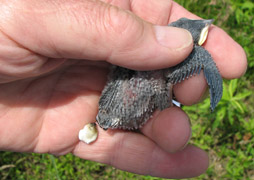
Also, watch for changes in both nestling and adult behavior.
Warning! If you plan to have your nestlings banded, your bander must wait until they are 11-12 days old, not younger and not older! See Banding Nestling Tree Swallows.
Concepts:
How are the nestlings changing?
- They are growing very rapidly.
- Their body proportions are changing. Their wings are becoming larger and abdomens smaller relative to the rest of their bodies.
- They are gaining weight at an explosive rate. Between days 4 and 7, when growth rate is highest, they may gain 2.5 grams per day, and when their weight levels off by about day 12-13 they will have reached 15 times their hatching weight and may even outweigh their parents!
- However, nestling weight can swing up and down due to weather variations that affect food supplies. Cold, wet and excessive wind may reduce weight gains.
- Bad weather can also cause slower feather growth because if parents aren’t able to supply enough food, more of each nestling’s energy must be diverted from growth to thermoregulation.
The pictures below show early nestling growth and development to day 12.
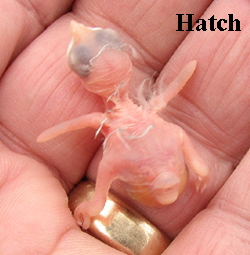
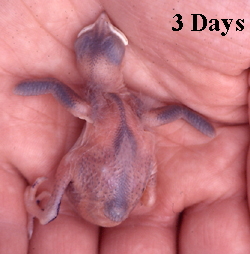
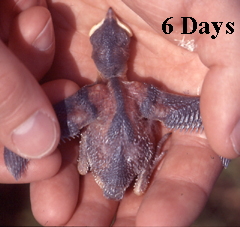
- Note how local strips on their bodies darken between hatching and day 6. These are “feather tracts” where feather follicles are rapidly growing.
- “Contour feathers” that will cover their bodies start to emerge at day 6 or 7. By about day 15 or 16 their bodies will appear fully feathered.
- “Flight feathers” of wings and tail, looking like quills at first, begin poking through the skin of wings and tails by about day 6 or 7. At this age these feathers are surrounded by waxy sheaths that protect them as they grow out from the pit-like follicles.
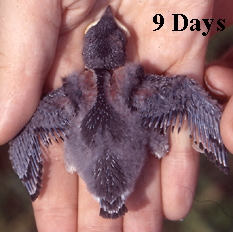
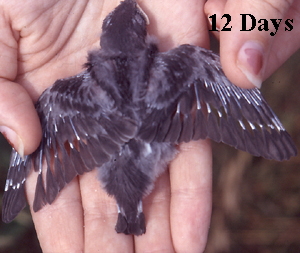
- By about day 10 to 12, wing and tail feathers that have partially erupted from their sheaths resemble little paintbrushes (see the tail feathers below). These flight feathers should be completely erupted by day 16 or so, and will continue to elongate through fledging and beyond.
- Also note the change in the wing size relative to body over this 12-day period. It’s pretty dramatic!
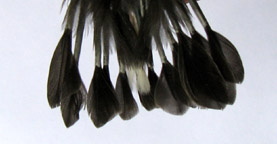
- Gradually, between about day five and day ten, eyes open from tiny slits to fully wide (see below). Now nestlings can use sight as well as sound and touch to sense when adults are arriving with food.
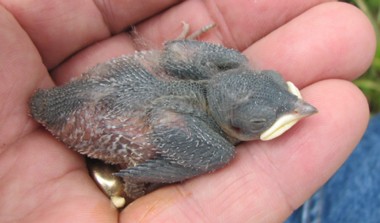
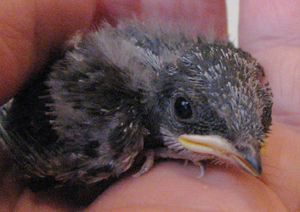
- Here’s a YouTube video showing Tree Swallow nestling growth and development between day 1 and day 12 after hatching.
Are nestling feathers the same color as adults’?
- No, nestlings are gradually acquiring a unique “juvenile plumage,” which they only have for the first few months of their lives.
- Juvenile upper bodies will be sooty gray with no trace of iridescent blue or green.
- Wings and tails will be dark gray.
- Their throats, breasts, and bellies will be a slightly duller white than adults’.
- Some juveniles will show a faint gray chest band.
How is nestling behavior changing?
- They are becoming more and more active, shifting position often.
- They are more squirmy when handled.
- The simple begging peeps they once gave when hungry have become much louder, more persistent, and complex as they compete with one another for food.
- They still huddle together but are apt to spill out of the nest cup as they become larger, especially during hot weather.
- As their feathers erupt, they begin to preen often and stretch their growing wings.
Is every nestling in a brood about the same size and state of growth and development?
- In some nests they are, but in others one or more nestlings may be lagging behind.
- The nestling at right in the picture below is noticeably smaller.
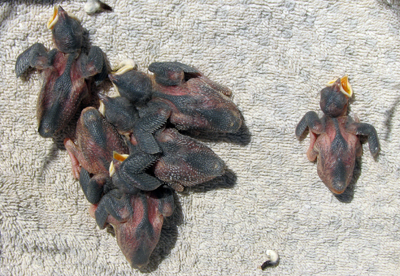
Where do you think a nestling that is smaller may have been in the clutch’s egg laying and hatching order?
- If it was from the last egg laid and was the last hatched by a day, it started with a size disadvantage. It may not be able to compete well for food with its older, larger nestmates, and if food supplies become short it may die, which reduces the number of young the parents must feed to a more manageable level.
- See Hatching and Small Tree Swallow Nestlings for a discussion of “brood reduction.“
- Individual nestlings can also lag due to disease, injury, or genetic weakness.
Who feeds the nestlings; males, females, or both?
- Normally both feed nestlings, with females tending to bring food a bit more often, although individual rates can vary.
- However, if one parent dies or deserts, the remaining parent will be supplying less total food for the young at the nest.
- Also, if a male successfully claims two nest sites and has a female and young in both (this happens occasionally), he usually limits his feeding efforts to one nest. The burden of feeding young at the other nest then falls mostly or entirely on its female.
- And since feeding a full brood is normally too difficult for single adults, smaller, weaker young in one-parent nests often starve.
Is the rate adults enter the boxes changing as young grow in size?
- Research has shown that 95% of adult visits to boxes containing nestlings involve feeding the young.
- Feeding rates do increase for several days as small nestlings grow rapidly. Their larger bodies require more food, and adults have to work harder and harder to satisfy them.
- Adults must seek and capture flying insects, and bring this food to their growing brood for 18-22 days straight. This is extremely energy-demanding.
- The metabolic rates of female Tree Swallows provisioning young average five times higher than their basal metabolic rates! It’s no wonder females typically lose weight during the nestling period.
- Rates of feeding young reach a peak by about day 8. Then they remain at this level until late in the nestling period when feeding rates taper off.
- Nests with more young show higher feeding rates by both males and females than nests with few young, but adults seldom are able to increase feeding in direct proportion to the number of young. So nestlings in large broods tend to get fed fewer total food items per hour.
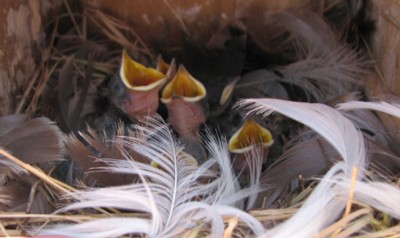
Does brood number effect rate of early nestling growth and development?
- Yes, young with fewer nestmates typically develop faster than those with many because they receive more food per hour than young in large broods.
- Evidence that young in larger broods tend to beg more intensely supports the idea they are experiencing greater competition for food.
As the young swallows grow in size, and as their insulating feathers develop, is heat from their mother’s brooding still needed?
- For at least a week after hatching the nestlings are not large enough either as individuals or huddled together in a ball to keep themselves sufficiently warm. They still need periodic brooding by their mother.
- However, by about day 8 or 9 they are usually large enough and becoming feathered enough to maintain their own body heat, to thermoregulate.
- By this time they have also become so large it’s impossible for the female adult to cover them all with her brood patch.
- Daytime brooding normally ends by day 10, but females may continue to sleep overnight with their young for several days, especially during cold, wet spells.
- Here’s a video showing how Francois Paquette’s female Tree Swallow changes her brooding behavior as her nestlings grow.
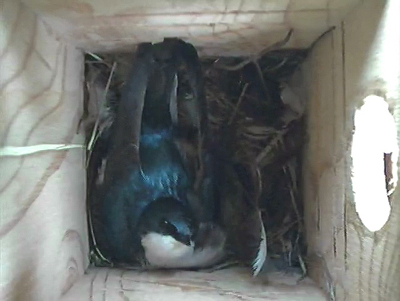
Have you noticed changes in how adults approach and enter boxes as nestlings grow and develop?
- As nestlings grow the need for speedy, efficient transfer of food from adult to young increases. Time lost is time adults can’t forage.
- Females now approach and enter boxes quickly and directly, swooping to the hole and ducking inside in a single fluid motion.
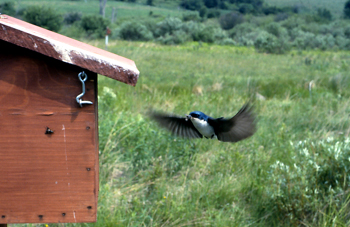
- Males may hesitate, often perching at the hole briefly before entering.
What other changes do you notice in the behavior of adults?
- As more efforts focus on feeding growing nestlings, adults have less time for other activities.
- There is less perching and body maintenance, less box guarding, and fewer songs and calls.
- One call that is still commonly heard is the “Gurgle” or Contact Call. Listen for adults giving it as they relieve each other at the nest or as they near the hole before entering. The Gurgle seems to alert an adult at the box to the other’s approach, so that relieving occurs efficiently. It also informs nestlings inside the box that an adult with food is arriving.
- Adults aren’t together much now, especially after females stop daytime brooding.
Have you noticed adults carrying out “fecal sacs” in their mouths?
- “Fecal sacs” are tough, flexible, gelatinous membranes enclosing a songbird nestlings’ feces.
- They seem to make it easier for adults to remove wastes from nests.
- Nestlings usually produce a fecal sac as a reflex immediately after being fed; in one end and out the other!
- The nestling that was fed usually turns around, backs up, and ejects a fecal sac.
- Adult songbirds, including Tree Swallows, may actually eat the fecal sacs of small nestlings.
- However, sacs of larger nestlings are usually removed and dropped away from the nest. See the example in the photo below by Brett Burleigh.
- You should be able to see adult swallows that are carrying white fecal sacs suddenly dip their heads in flight, opening their bills to drop the sac.
- Here’s a cool in-box video of adult Tree Swallows disposing of fecal sacs after feeding their young.
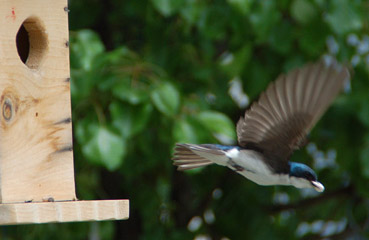
Why do parent Tree Swallows remove fecal sacs?
- Sanitation is probably the main reason. Harmful germs could grow in soiled nests.
- The smell of accumulated waste could attract predators.
- Nestling feathers smeared by waste could lose their insulating value.
Questions for the next Topic: Causes of Tree Swallow Mortality
- Have you noted dead or missing nestlings when checking boxes?
- What could kill nestling songbirds?
- How have you tried to prevent swallow mortality?
———————————————————————————-
Home: Tree Swallow Nest Box Projects
Creating Tree Swallow Nest Box Projects
Spring Return
Nesting Season Behavior
Song and Calls
Nest Site Claiming
Pair Formation
Nest Building
Bird Flight
Mating and Paternity
Diary of One Season at Salmon Creek
Monitoring Nest Boxes and Keeping Records
Making Box Checks Keeping Box Records Control Sheets Season Summaries Print Sheets
Banding Your Tree Swallows Banding Adults Banding Nestlings
Tree Swallows in Research Research Bibliography Glossary of Terms